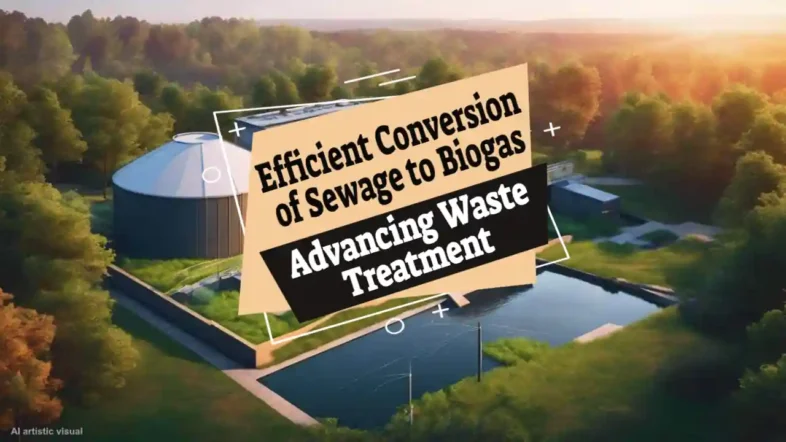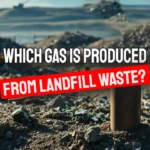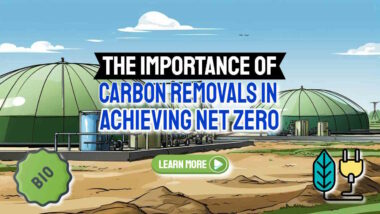Read on to learn about advancing foul waste treatment, for sustainable energy generation through the efficient conversion of sewage solids to biogas.
When we talk about waste, it can seem like a dirty subject. But what if we could turn that waste into something useful? Imagine the mucky water and sludge from our toilets and drains becoming a clean source of energy.
That's exactly what happens when we convert sewage to biogas – it's like magic for the environment!
Did you know that with some smart science, sewage doesn't just go to waste? It can be transformed into biogas, which is a kind of gas that can heat our homes and even power buses! This blog post will show you how this clever trick works and why it matters for our planet.
It's time to see waste in a whole new light – let’s dive in!
Key Takeaways
- Sewage can be transformed into biogas, a renewable energy that heats homes and powers vehicles.
- Pre-treatment methods before anaerobic digestion increase the amount of biogas produced from sewage.
- Partnerships among waste management facilities, energy companies, and government are key to scaling up biogas production.
- Advancements in technology improve the safety and efficiency of converting sewage to biogas for sustainable energy generation.
- Using converted sewage for biogas aligns with net zero goals by providing green solutions for industries and communities.
Waste Treatment: Advancing Towards Sustainability
Waste treatment is crucial in the shift towards sustainability, and biogas production from sewage offers a promising solution. This innovative approach not only reduces environmental impact but also generates renewable energy for a more sustainable future.

What is biogas and how is it produced through sewage treatment?
Biogas is a type of renewable energy made during sewage treatment. Sewage contains organic matter that microbes break down in an oxygen-free environment. This process is called anaerobic digestion.
It happens in large tanks at sewage treatment plants.
As the microbes work, they release biogas. The gas mainly has methane and carbon dioxide with small amounts of other gases. Biogas can become heat and electricity or be cleaned and used as fuel.
Turning sludge from sewage into biogas cuts down on waste and lowers pollution risks to waterways. It helps turn something dirty into clean energy for our homes and businesses. This method also decreases greenhouse gases, making it good for the planet.
Importance of efficient waste treatment
Efficient waste treatment is crucial for sustainable energy generation and environmental preservation. Converting sewage to biogas through advanced waste treatment methods not only offers a renewable energy source but also significantly reduces greenhouse gas emissions and the risk of water pollution.
The efficient conversion of organic waste into biogas serves as an important step towards promoting sustainable energy generation, mitigating environmental concerns associated with sewage treatment, and contributing to the reduction of carbon footprint.
The importance of advancing waste treatment methods lies in the potential to improve carbon conversion efficiency by over 50%, making it a more sustainable approach for energy generation.
Innovative Solution: Converting Sludge to Biogas
Researchers are exploring pre-treatment methods to efficiently convert sludge into biogas, offering numerous benefits in waste management and sustainable energy generation. This innovative solution has the potential to revolutionise the way we approach sewage treatment and energy production.

Research on pre-treatment methods
Scientists are actively researching pre-treatment methods to efficiently convert sewage into biogas. This process involves breaking down organic matter before it enters the anaerobic digestion stage, maximising biogas production.
By optimising pre-treatment, carbon conversion efficiency can be significantly improved, leading to a more sustainable and effective method for generating renewable energy from sewage sludge.
This innovative approach represents a crucial step towards advancing waste treatment technology and promoting sustainable energy generation through the efficient conversion of sewage to biogas.
Benefits of adding a pre-treatment step
Following the research on pre-treatment methods, adding a pre-treatment step before biogas conversion offers several benefits. Firstly, it enhances the breakdown of organic matter, leading to increased biogas production and improved carbon conversion efficiency.
This results in a more sustainable and efficient method for energy generation while mitigating environmental concerns associated with sewage treatment. Additionally, by optimising the pre-treatment process, operational costs can be reduced significantly, making biogas production more economically viable.
Furthermore, adding a pre-treatment step helps in reducing the level of contaminants in the waste stream, resulting in cleaner water discharge post-treatment. This contributes to better overall wastewater treatment and improved environmental sustainability.
Potential uses for converted biogas
- Converted biogas can be used for heating purposes in residential, commercial, and industrial settings.
- The produced biogas can be utilised as a source of renewable energy for electricity generation.
- It serves as an eco – friendly fuel alternative for vehicles, reducing greenhouse gas emissions and promoting sustainable transport.
- Converted biogas can be injected into the natural gas grid to provide a sustainable energy source for various applications.
- It offers a reliable source of energy for cooking and heating in off – grid areas where traditional energy sources are scarce.
- Biomethane from converted biogas has the potential to be used as a biofuel in transport, reducing reliance on fossil fuels.
Advancements in Biogas Conversion for Sustainable Energy Generation
The advancement in biogas conversion plays a crucial role in the transition towards green energy, with collaborations and partnerships driving production and innovative methods improving thermal management and battery safety.

Role of the conversion of sewage to biogas in the green energy transition
Biogas plays a crucial role in the green energy transition, offering a renewable and sustainable energy source. It provides an environmentally friendly alternative to traditional fossil fuels, helping to reduce greenhouse gas emissions and mitigate climate change.
Biogas can be harnessed from sewage treatment processes, diverting organic waste from landfills and contributing to a circular economy. This versatile energy source has the potential for diverse applications, from powering local communities to serving as a renewable natural gas source – making it an essential component in advancing towards a greener and more sustainable future.
Collaborating with experts and stakeholders is vital for maximising the potential of biogas production at scale while unlocking opportunities for sustainable energy generation. Efforts should focus on developing innovative solutions that enable efficient conversion of waste into valuable energy sources – paving the way for a more sustainable future.
Collaboration and partnerships for biogas production
Partnerships with local waste management facilities and energy companies are crucial for scaling up biogas production. Collaborating with these entities can provide opportunities for sourcing organic waste, optimising the efficiency of biogas plants, and expanding the use of converted biogas in local communities.
By working together, we can maximise the potential of sewage sludge conversion to produce renewable energy, contributing to sustainable waste management and reducing greenhouse gas emissions.
Government officials play a vital role in fostering collaboration among different stakeholders in promoting biogas production. Policy support and incentives can encourage partnerships between wastewater treatment plants, technology developers, and energy investors to advance the adoption of efficient sewage-to-biogas conversion technologies.
Together with environmental researchers' contributions, these collaborations pave the way for innovative solutions that address both waste treatment challenges and sustainable energy generation needs at a local level.
Advancements in thermal management and battery safety
New advancements have improved thermal management in biogas systems. These developments ensure optimal operating temperatures, enhancing the efficiency of biogas production. Enhanced battery safety measures have been implemented, mitigating potential hazards and ensuring a secure energy storage environment.
These improvements represent significant progress towards sustainable and safe biogas energy generation.
Efficient thermal management optimises biogas production by maintaining ideal conditions for biochemical reactions. With improved battery safety measures, the risk of accidents is reduced, promoting a secure energy storage ecosystem.
Looking Towards the Future
Potential for net zero goals through home decarbonisation and consumer-driven policy recommendations for energy consumption indicate a promising path towards sustainable waste treatment.
Learn more about the efficient conversion of sewage to biogas for sustainable energy generation by reading our full blog!
Potential for net zero goals through home decarbonisation
Efficient conversion of sewage to biogas holds the potential for home decarbonisation, contributing to net zero goals. By harnessing biogas production from sewage treatment, households can reduce their reliance on non-renewable energy sources, ultimately lowering carbon emissions.
This innovation aligns with efforts in advancing waste treatment for sustainable energy generation and supports the transition towards greener energy solutions.
As we look towards the future and consider consumer-driven policy recommendations for energy consumption, it's imperative to explore long-term sustainability through green solutions for industries and communities.
These steps are crucial as we seek to mitigate environmental concerns associated with traditional energy sources and strive towards a more sustainable future.
Consumer-driven policy recommendations for energy consumption

Transitioning from potential net zero goals through home decarbonisation, policymakers need to consider consumer-driven policy recommendations for energy consumption.
Encouraging the adoption of renewable energy sources in households and industries is vital. Implementing incentives such as tax breaks or subsidies for renewable energy installations can significantly drive consumer participation in sustainable energy consumption.
Moreover, educating consumers about the environmental impact of their energy choices is crucial. Increasing public awareness about the benefits of sustainable energy generation can lead to more informed decisions.
Additionally, creating regulations that promote the use of eco-friendly technologies and practices would contribute to a greener and more sustainable future. Ultimately, policies should aim to empower consumers towards making environmentally conscious choices when it comes to their energy consumption.
Lastly, fostering collaboration between government bodies, waste management professionals and industry experts will be key to accelerating the transition towards sustainable energy generation.
Long-term sustainability through green solutions for industries and communities
Efficiently converting sewage into biogas offers long-term sustainability for industries and communities. Biogas, derived from organic waste, provides a renewable natural gas source for sustainable energy generation.
The advanced waste treatment methods enable the production of biomethane, contributing to green solutions for industries and promoting sustainable energy generation. This innovative approach reduces greenhouse gas emissions and pollution while fostering environmental conservation efforts in communities.
Integrating biogas conversion into industrial processes supports the move towards net-zero goals. It enables efficient waste-to-energy (WtE) conversion, advancing waste treatment and reducing environmental concerns associated with sewage treatment.
Conclusion
In conclusion, the efficient conversion of sewage to biogas offers a sustainable solution for waste treatment and energy generation. Implementing innovative methods can significantly improve carbon conversion efficiency in sewage treatment.
These advancements have the potential to make a substantial impact on reducing greenhouse gas emissions. For further exploration, consider looking into consumer-driven policy recommendations and green solutions for industries.
Let's embrace these practical strategies to advance waste treatment for sustainable energy generation!
FAQs
1. What is biogas, and how do we get it from sewage?
Biogas is a type of biofuel that's made when sewage breaks down. It happens in special tanks where bacteria eat the waste and produce biomethane gas.
2. Can syngas production be part of making energy from sewage?
Yes, producing syngas is a step in turning sewage into sustainable energy. It's a gas that can also be used to make electricity or heat homes.
3. How does converting sewage to biogas help the environment?
Turning sewage into biogas reduces waste and makes clean energy. This helps cut down on pollution and lowers our need for fossil fuels.
4. Is it efficient to make fuel from wastewater treatment?
Absolutely! With new technology, transforming sewage into biofuel-like biomethane has become an effective way to generate renewable energy.
Best Low Carbon Farming Practices & Techniques
Farmers are turning to low carbon techniques like no-till farming and precision agriculture to combat climate change. These practices not only reduce emissions but also improve soil health and farm profitability, offering a resilient future for agriculture as weather patterns grow increasingly unpredictable…
Which Gas is Produced from Landfill Waste: The Gas that Trash Produces…
Discover which gas is produced from landfill waste and understand its environmental impact and potential energy use. Explore landfill gas management.
Is Natural Gas Sustainable? Explore the Facts
Discover the truth about the sustainability of natural gas on our blog.
Methane Capture Systems: The Cure For Global Oil Addiction?
The world runs on oil, but this dependency creates serious problems. Air gets polluted, water sources get contaminated, and the climate crisis worsens. People are looking for better ways to reduce harm caused by our “oil addiction.” Methane capture systems might be a solution. These systems trap harmful gas released during oil and gas production. […]








